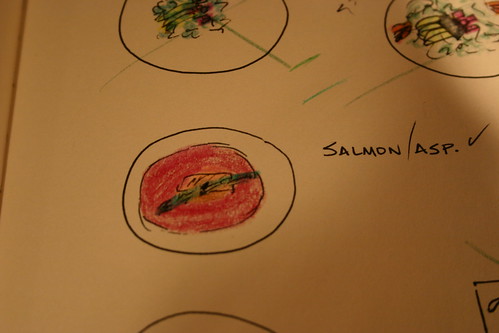
An account of the intimate dinner that I cooked for the new First Lady.
On Super Tuesday, we booked our hotel; the night of the election, our plane tickets. Perhaps we were optimistic, but if Barack won, I wanted to be there. I was in Washington for law school in 1993 and on that cold January evening, I saw all the frothy dresses and polished tuxes trotted out for President Clinton and so wished that I too could go to the ball.
There was, however, one small detail that I neglected to remember – I hate crowds. While watching political rallies on the small screen, they always so seem so inspiring – strangers rubbing shoulders for a common purpose. But in reality, they just make me itchy. As the crowd estimates continued to rise after the election, we began to rethink our travel plans. Cancelling the trip was not a possibility. Our itinerary included flying through Long Island to drop off our son, Thor, with my mom and dad. For months, he had been telling friends that he wanted Barack to win so that he could visit his grandparents. Plans had been made, play dates arranged –- it was set. At the very least, we were going to New York.
Taking the money we would have spent on ball tickets, peak hotel rates and all the rest, we booked a suite at the Sofitel and reserved tables at Gotham Bar & Grill, Blue Hill & Daniel. While Barack, in his polished tux, and Michelle, in her very frothy dress danced to “At Last” at one of the many inaugural balls on January 20, we lifted a glass of champagne at the uncrowded Restaurant Daniel on the Upper East Side.
In retrospect, this post hoc decision made perfect sense given that my support for Barack and his campaign were not born as the result of one of his soaring crowd-pleasing speeches, but instead at a similarly intimate dinner that I cooked for Michelle and four of her closest friends.
After the momentous announcement was made on another cold day in early 2007, a smattering of Obama signs began to appear in Chicago windows. It was around this time that I got the call. During the previous October, I had donated a package to Healthy Schools Campaign for their annual benefit. Called “A Sustainable Evening,” it was a multi-course dinner with pairings from Candid Wines. I often donate packages like these to charities with which I’m involved. They’re great PR and surprisingly, given the price they tend to fetch, about a third of a time the bidder doesn’t redeem. This time was different.
Cindy Moelis, a good friend of Michelle’s, had purchased the item. Originally, she’d planned to use it for her and her husband. But as the campaign began in earnest, she realized that over the next few months, and perhaps years, there would be few opportunities for Michelle to spend an intimate evening with her close female friends. Accordingly, the dinner was intended in some respects to be a last hurrah, though one without fanfare – just a simple evening of good friends enjoying good food and wine. Working with Cindy, we developed a menu that took into account Michelle’s taste, the guest’s dietary restrictions and our philosophy of sustainable sourcing. The event was challenging in many respects. Off-site catering has many difficulties, ones that are only compounded when a site visit or even communication with the host is not possible. We also had the time of year to contend with; April, the month of the event, is a sort of netherworld for local eating in the Midwest. The growing season hasn’t kicked in, but the thought of yet one more root vegetable is too much to bear.
Despite these challenges, the event went beautifully. We served a trio of snacks to start: crisp wafers of Wisconsin parmesan, salt-crusted almonds and local radish slices topped with herbed goat butter. The first course was a salad of local baby greens and herbs topped with seared Maine diver scallops and dressed with vinaigrette made from an artisanal California cider vinegar. We served a soup: rich chicken broth, cooked down twice, in it, a single ravioli filled with a mixture of sweet peas, Prairie Fruits Farm goat cheese and grey shallots. The ravioli was topped with a tussle of frizzled Wettstein’s ham and pea shoots. The entrée was seared King salmon filets set atop a potato puree surrounded by a moat of rich red wine sauce made from Lynfred’s Vin de City Red. The filets were garnished with a handful of asparagus tips. In the bread basket, there was rich foccacia, rosemary crackers and country bread — all house made. Our dessert was a rhubarb crème brulee partnered with Meyer lemon madeleines. We finished up with French-pressed Intelligentia coffee and truffles from Coco Rouge.

After the tumultuous primary and campaign, that night all seems so long ago, but I remember Michelle being down to earth and kind. Malia and Sascha were there with the children of the other guests (they all ate pizza and played games downstairs). Malia was thoughtful and composed; Sascha, a pistol. But I particularly recall our departure as I was the only member of our team to get a big hug and kiss on the cheek from Michelle – a moment that I treasure.
I’ve been thinking about this evening in light of the heated discussions in the food community about who should be the White House chef in President Obama’s administration. A “controversy” recently resolved by the retention of Chef Cristeta Comerford and the appointment of private chef Sam Kass to serve under her. Ordinarily, our Sustainable Evening package has a strong educational component. Both the folks at Candid Wines and I really enjoy talking with guests about sustainable methods of production, the farmers, producers and wineries from whom we source and generally about the philosophy of sustainability. In fact, in many instances, the guests sit in the kitchen with us and it becomes an interactive event. While it would have been wonderful to have the opportunity to do this with such a high profile individual as Michelle, when we learned what the intent of the dinner was, we limited the didactic element to a minimum – essentially a description of each dish and a short presentation on the philosophy of our companies. Based upon this experience, I’ve been both amused and troubled by the debate on the role of the White House chef.
Initially, I thought it interesting how so many high profile food writers could misunderstand the role of White House chef. As Walter Scheib, Executive Chef in both the Clinton and Bush administrations, has made clear in his interviews on the subject, the job is not to promote one’s own agenda, but to serve at the pleasure of the president and first lady. As Tony Mantuano told Phil Vettel when asked if he would want the job: "I don't think so," he said. "It'd be like being the chef of a giant hotel. You have to make peanut butter and jelly for the kids, plus private dinners, room service—unless you’re a big corporate hotel guy, I'm not sure you'd want it." Taking the job also means no book tours, no television shows. Imagine the absurdity of Rick Bayless or Art Smith severing ties with their successful restaurants and media enterprises to become a banquet chef.
But what really bothered me was how many titans of the food world were in effect calling upon the Obamas to fire the first female executive White House chef. These demands were particularly egregious when it turns out that she had been doing all along exactly what they were urging. Former White House Chef Scheib has made it clear that Chef Comerford sources locally, uses organic and sustainable products, including grass fed beef and sustainably caught fish. In fact, much of the produce used for the first family was grown in a small roof top garden at the White House. The problem seems not to be that she wasn’t doing the desired thing; instead, it was that she hadn’t become famous in doing so. Doing her job well, discretely and without fanfare was insufficient.
It seems that Sam Kass is the ideal candidate for his new job under Comerford. Obviously, he does his job well, but is also discrete. With the exception of Time Out Chicago, Kass’ name never came up in any of the articles speculating on the White House chef. He also clearly cares about the public good. While I never made it over to any of the Re-thinking Soup sessions at Hull House, several of my friends and colleagues have spoken at them and thought highly of the events. In fact, Kass’ “speech” reprinted in yesterday’s New York Times Well blog introduces two of them — Jean Saunders of Healthy Schools Campaign (the same organization to which I donated my Sustainable Evening package) and Josephine Lauer formerly of Organic School Project. However, in these events, he was bringing in the experts to speak, instead of pushing his own agenda. I think this experience too will serve him well. I would imagine that neither the President nor the First Lady will would want a lecture on sustainable fisheries or the benefits of grass-fed beef each time that they sit down to dinner. The table can be a place for discussion and learning, but for someone with stressful job, its restorative properties are more important. While it’s certainly positive that Kass is knowledgeable about sustainability issues, as Comerford I’m sure is as well, other qualities such as discretion and a sense of duty are equally important in such a sensitive assignment. The role of White House chef is not a bully pulpit. I wish the Kass the best of luck. I would assume that neither his employers nor his new boss will be much of a problem for him. Rather, his biggest critic may well be the public, which seems to prefer a “celebrity” face over a dutiful servant.
Two recipes from our dinner:
Radishes Topped with Goat Butter
INGREDIENTS:
4 ounces goat butter, softened
2 tablespoons mixed chopped herbs (such as basil or tarragon, chives, chervil or parsley)
1 bunch radishes, stemmed and cleaned
Coarse sea salt for garnish
METHOD: Mix together butter and chopped herbs. Slice radishes thinly and soak in cold water. Dry slices and top with goat butter. Garnish with coarse sea salt.
Cheese Wafers
INGREDIENTS:
½ pound parmesan cheese, grated (I use Stravecchio, a parmesan-style cheese produced in Wisconsin)
EQUIPMENT: Baking sheet, silpat or parchment
METHOD: Preheat oven to 350° F. On a parchment or silpat-lined baking sheets, scoop out teaspoon size rounds of grated parmesan cheese. Bake until crisp about 7-10 minutes.





I read in several places that Bush installed solar panels on the roof (twenty years after Reagan had them removed). Did the oil and gas industry keep him from announcing it?
ReplyDeleteDoes the White House really have a rooftop garden?
I'd only known about the solar panels put up by Carter and then removed by Reagan. It's a good question. The white house garden was referred to by Scheib in an interview about the chef situation. According to him, it was a small garden for the first family's purposes.
ReplyDelete